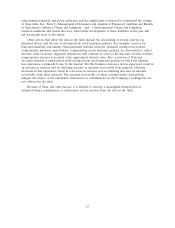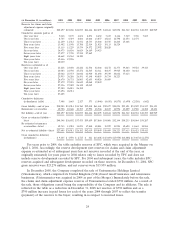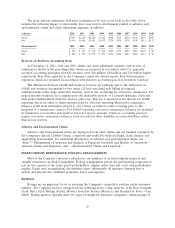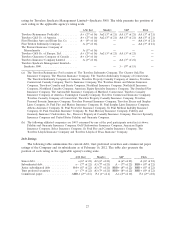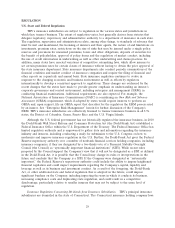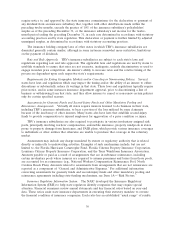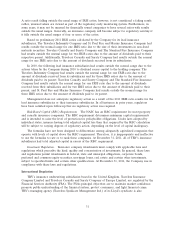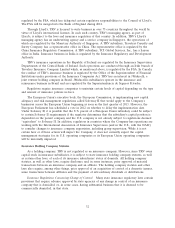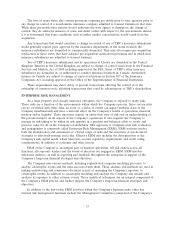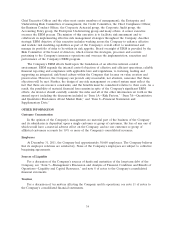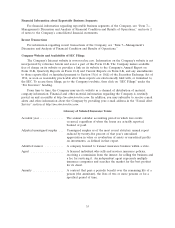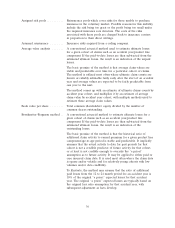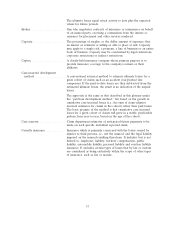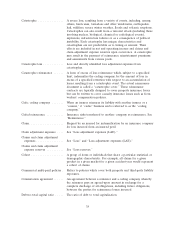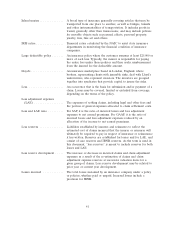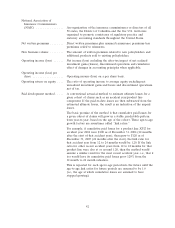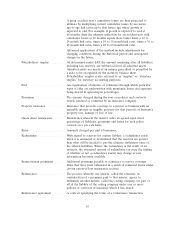Travelers 2011 Annual Report Download - page 45
Download and view the complete annual report
Please find page 45 of the 2011 Travelers annual report below. You can navigate through the pages in the report by either clicking on the pages listed below, or by using the keyword search tool below to find specific information within the annual report.The laws of many states also contain provisions requiring pre-notification to state agencies prior to
any change in control of a non-domestic insurance company admitted to transact business in that state.
While these pre-notification statutes do not authorize the state agency to disapprove the change of
control, they do authorize issuance of cease and desist orders with respect to the non-domestic insurer
if it is determined that some conditions, such as undue market concentration, would result from the
acquisition.
Any transactions that would constitute a change in control of any of TRV’s insurance subsidiaries
would generally require prior approval by the insurance departments of the states in which the
insurance subsidiaries are domiciled or commercially domiciled. They may also require pre-acquisition
notification in those states that have adopted pre-acquisition notification provisions and in which such
insurance subsidiaries are admitted to transact business.
Two of TRV’s insurance subsidiaries and its operations at Lloyd’s are domiciled in the United
Kingdom. Insurers in the United Kingdom are subject to change of control restrictions in the Financial
Services and Markets Act of 2000 including approval of the FSA. Some of TRV’s other insurance
subsidiaries are domiciled in, or authorized to conduct insurance business in, Canada. Authorized
insurers in Canada are subject to change of control restrictions in Section 407 of the Insurance
Companies Act, including approval of the Office of the Superintendent of Financial Institutions.
These requirements may deter, delay or prevent transactions affecting the control of or the
ownership of common stock, including transactions that could be advantageous to TRV’s shareholders.
ENTERPRISE RISK MANAGEMENT
As a large property and casualty insurance enterprise, the Company is exposed to many risks.
These risks are a function of the environments within which the Company operates. Since certain risks
can be correlated with other risks, an event or a series of events can impact multiple areas of the
Company simultaneously and have a material effect on the Company’s results of operations, financial
position and/or liquidity. These exposures require an entity-wide view of risk and an understanding of
the potential impact on all aspects of the Company’s operations. It also requires the Company to
manage its risk-taking to be within its risk appetite in a prudent and balanced effort to create and
preserve value for all of the Company’s stakeholders. This approach to Company-wide risk evaluation
and management is commonly called Enterprise Risk Management (ERM). ERM activities involve
both the identification and assessment of a broad range of risks and the execution of synchronized
strategies to effectively manage such risks. Effective ERM also includes the determination of the
Company’s risk capital needs, which takes into account regulatory requirements and credit rating
considerations, in addition to economic and other factors.
ERM at the Company is an integral part of business operations. All risk owners across all
functions, all corporate leaders and the board of directors are engaged in ERM. ERM involves
risk-based analytics, as well as reporting and feedback throughout the enterprise in support of the
Company’s long-term financial strategies and objectives.
The Company uses various methods, including sophisticated computer modeling processes, to
analyze catastrophic events and the risks associated with them. These analyses and methods are used in
making underwriting and reinsurance decisions as part of managing the Company’s exposure to
catastrophic events. In addition to catastrophe modeling and analysis, the Company also models and
analyzes its exposure to other extreme events. These analytical techniques are an integral component of
the Company’s ERM process and further support the Company’s long-term financial strategies and
objectives.
In addition to the day-to-day ERM activities within the Company’s business units, other key
internal risk management functions include the Management Committee (comprised of the Company’s
33


